Web 2.0 Report: Social Graphing, Network Mapping, and Business Gains
VerifiedAdded on 2022/08/19
|5
|1090
|14
Report
AI Summary
This report explores the significance of Web 2.0 technologies, particularly focusing on social graphing and network mapping, and their impact on businesses. It examines the benefits of Web 2.0 in various industries, highlighting the use of social graphics for understanding patterns, managing groupings, and detecting networks. The report also discusses network mapping for managing actors and relationships, emphasizing the competitive advantages businesses can gain through Web 2.0. It delves into the tools and processes associated with Web 2.0, such as social networking, blogs, file sharing, and communication tools, as well as backend processes like RSS and tagging. The report concludes by emphasizing the importance of considering factors like internet connectivity and cybersecurity when implementing Web 2.0 technologies to improve business performance. References are included using APA style.
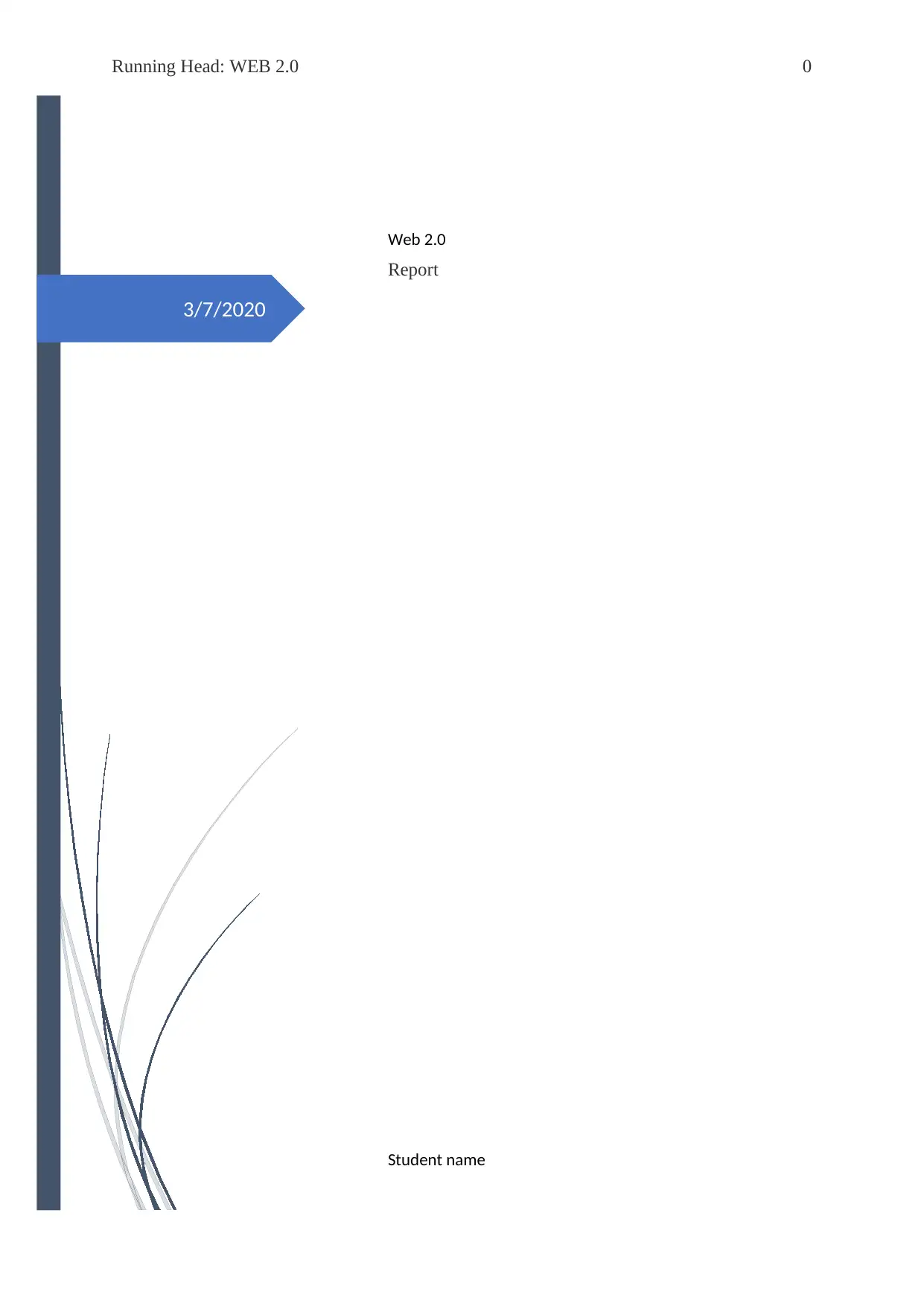
3/7/2020
Running Head: WEB 2.0 0
Web 2.0
Report
Student name
Running Head: WEB 2.0 0
Web 2.0
Report
Student name
Paraphrase This Document
Need a fresh take? Get an instant paraphrase of this document with our AI Paraphraser
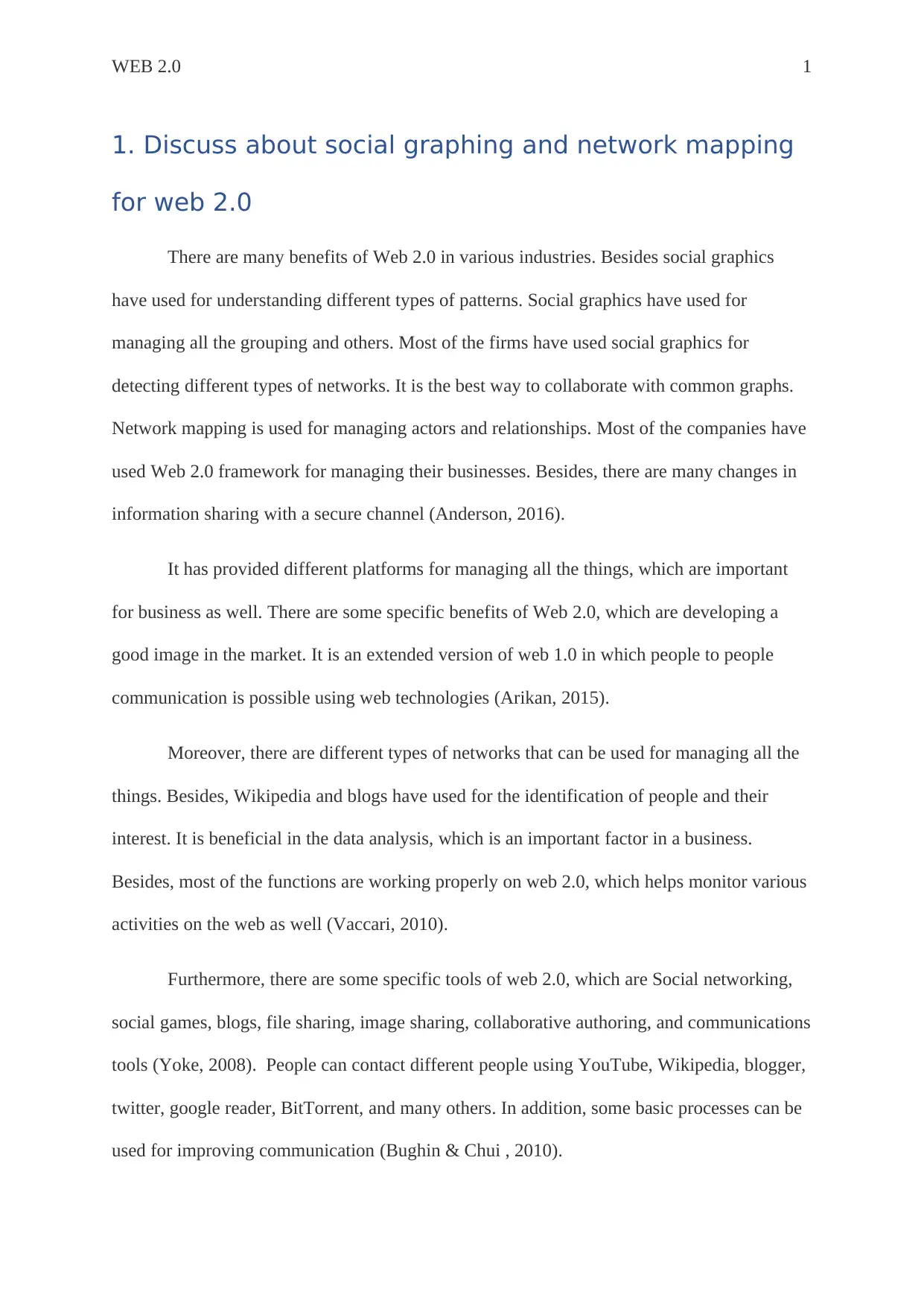
WEB 2.0 1
1. Discuss about social graphing and network mapping
for web 2.0
There are many benefits of Web 2.0 in various industries. Besides social graphics
have used for understanding different types of patterns. Social graphics have used for
managing all the grouping and others. Most of the firms have used social graphics for
detecting different types of networks. It is the best way to collaborate with common graphs.
Network mapping is used for managing actors and relationships. Most of the companies have
used Web 2.0 framework for managing their businesses. Besides, there are many changes in
information sharing with a secure channel (Anderson, 2016).
It has provided different platforms for managing all the things, which are important
for business as well. There are some specific benefits of Web 2.0, which are developing a
good image in the market. It is an extended version of web 1.0 in which people to people
communication is possible using web technologies (Arikan, 2015).
Moreover, there are different types of networks that can be used for managing all the
things. Besides, Wikipedia and blogs have used for the identification of people and their
interest. It is beneficial in the data analysis, which is an important factor in a business.
Besides, most of the functions are working properly on web 2.0, which helps monitor various
activities on the web as well (Vaccari, 2010).
Furthermore, there are some specific tools of web 2.0, which are Social networking,
social games, blogs, file sharing, image sharing, collaborative authoring, and communications
tools (Yoke, 2008). People can contact different people using YouTube, Wikipedia, blogger,
twitter, google reader, BitTorrent, and many others. In addition, some basic processes can be
used for improving communication (Bughin & Chui , 2010).
1. Discuss about social graphing and network mapping
for web 2.0
There are many benefits of Web 2.0 in various industries. Besides social graphics
have used for understanding different types of patterns. Social graphics have used for
managing all the grouping and others. Most of the firms have used social graphics for
detecting different types of networks. It is the best way to collaborate with common graphs.
Network mapping is used for managing actors and relationships. Most of the companies have
used Web 2.0 framework for managing their businesses. Besides, there are many changes in
information sharing with a secure channel (Anderson, 2016).
It has provided different platforms for managing all the things, which are important
for business as well. There are some specific benefits of Web 2.0, which are developing a
good image in the market. It is an extended version of web 1.0 in which people to people
communication is possible using web technologies (Arikan, 2015).
Moreover, there are different types of networks that can be used for managing all the
things. Besides, Wikipedia and blogs have used for the identification of people and their
interest. It is beneficial in the data analysis, which is an important factor in a business.
Besides, most of the functions are working properly on web 2.0, which helps monitor various
activities on the web as well (Vaccari, 2010).
Furthermore, there are some specific tools of web 2.0, which are Social networking,
social games, blogs, file sharing, image sharing, collaborative authoring, and communications
tools (Yoke, 2008). People can contact different people using YouTube, Wikipedia, blogger,
twitter, google reader, BitTorrent, and many others. In addition, some basic processes can be
used for improving communication (Bughin & Chui , 2010).
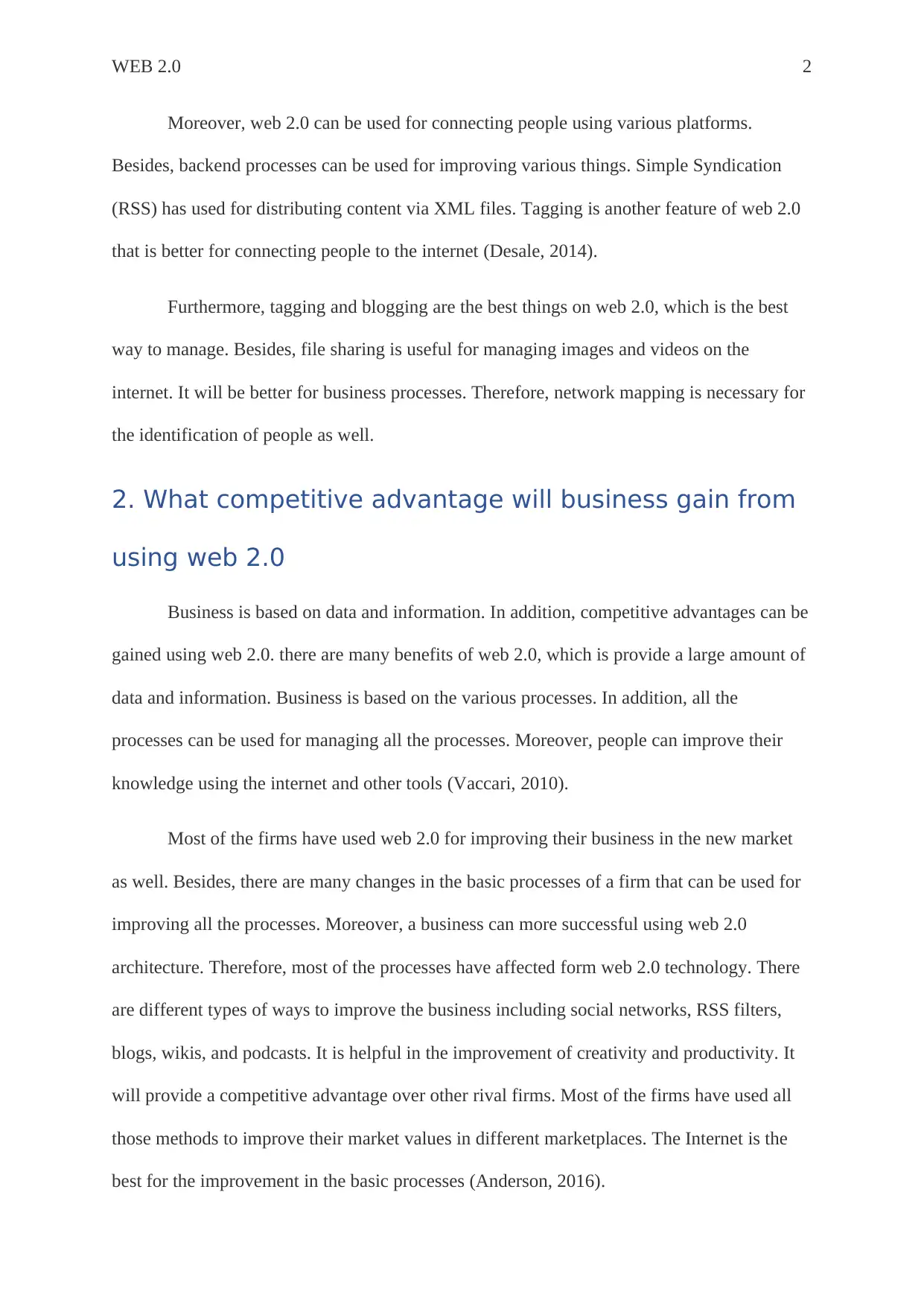
WEB 2.0 2
Moreover, web 2.0 can be used for connecting people using various platforms.
Besides, backend processes can be used for improving various things. Simple Syndication
(RSS) has used for distributing content via XML files. Tagging is another feature of web 2.0
that is better for connecting people to the internet (Desale, 2014).
Furthermore, tagging and blogging are the best things on web 2.0, which is the best
way to manage. Besides, file sharing is useful for managing images and videos on the
internet. It will be better for business processes. Therefore, network mapping is necessary for
the identification of people as well.
2. What competitive advantage will business gain from
using web 2.0
Business is based on data and information. In addition, competitive advantages can be
gained using web 2.0. there are many benefits of web 2.0, which is provide a large amount of
data and information. Business is based on the various processes. In addition, all the
processes can be used for managing all the processes. Moreover, people can improve their
knowledge using the internet and other tools (Vaccari, 2010).
Most of the firms have used web 2.0 for improving their business in the new market
as well. Besides, there are many changes in the basic processes of a firm that can be used for
improving all the processes. Moreover, a business can more successful using web 2.0
architecture. Therefore, most of the processes have affected form web 2.0 technology. There
are different types of ways to improve the business including social networks, RSS filters,
blogs, wikis, and podcasts. It is helpful in the improvement of creativity and productivity. It
will provide a competitive advantage over other rival firms. Most of the firms have used all
those methods to improve their market values in different marketplaces. The Internet is the
best for the improvement in the basic processes (Anderson, 2016).
Moreover, web 2.0 can be used for connecting people using various platforms.
Besides, backend processes can be used for improving various things. Simple Syndication
(RSS) has used for distributing content via XML files. Tagging is another feature of web 2.0
that is better for connecting people to the internet (Desale, 2014).
Furthermore, tagging and blogging are the best things on web 2.0, which is the best
way to manage. Besides, file sharing is useful for managing images and videos on the
internet. It will be better for business processes. Therefore, network mapping is necessary for
the identification of people as well.
2. What competitive advantage will business gain from
using web 2.0
Business is based on data and information. In addition, competitive advantages can be
gained using web 2.0. there are many benefits of web 2.0, which is provide a large amount of
data and information. Business is based on the various processes. In addition, all the
processes can be used for managing all the processes. Moreover, people can improve their
knowledge using the internet and other tools (Vaccari, 2010).
Most of the firms have used web 2.0 for improving their business in the new market
as well. Besides, there are many changes in the basic processes of a firm that can be used for
improving all the processes. Moreover, a business can more successful using web 2.0
architecture. Therefore, most of the processes have affected form web 2.0 technology. There
are different types of ways to improve the business including social networks, RSS filters,
blogs, wikis, and podcasts. It is helpful in the improvement of creativity and productivity. It
will provide a competitive advantage over other rival firms. Most of the firms have used all
those methods to improve their market values in different marketplaces. The Internet is the
best for the improvement in the basic processes (Anderson, 2016).
⊘ This is a preview!⊘
Do you want full access?
Subscribe today to unlock all pages.

Trusted by 1+ million students worldwide
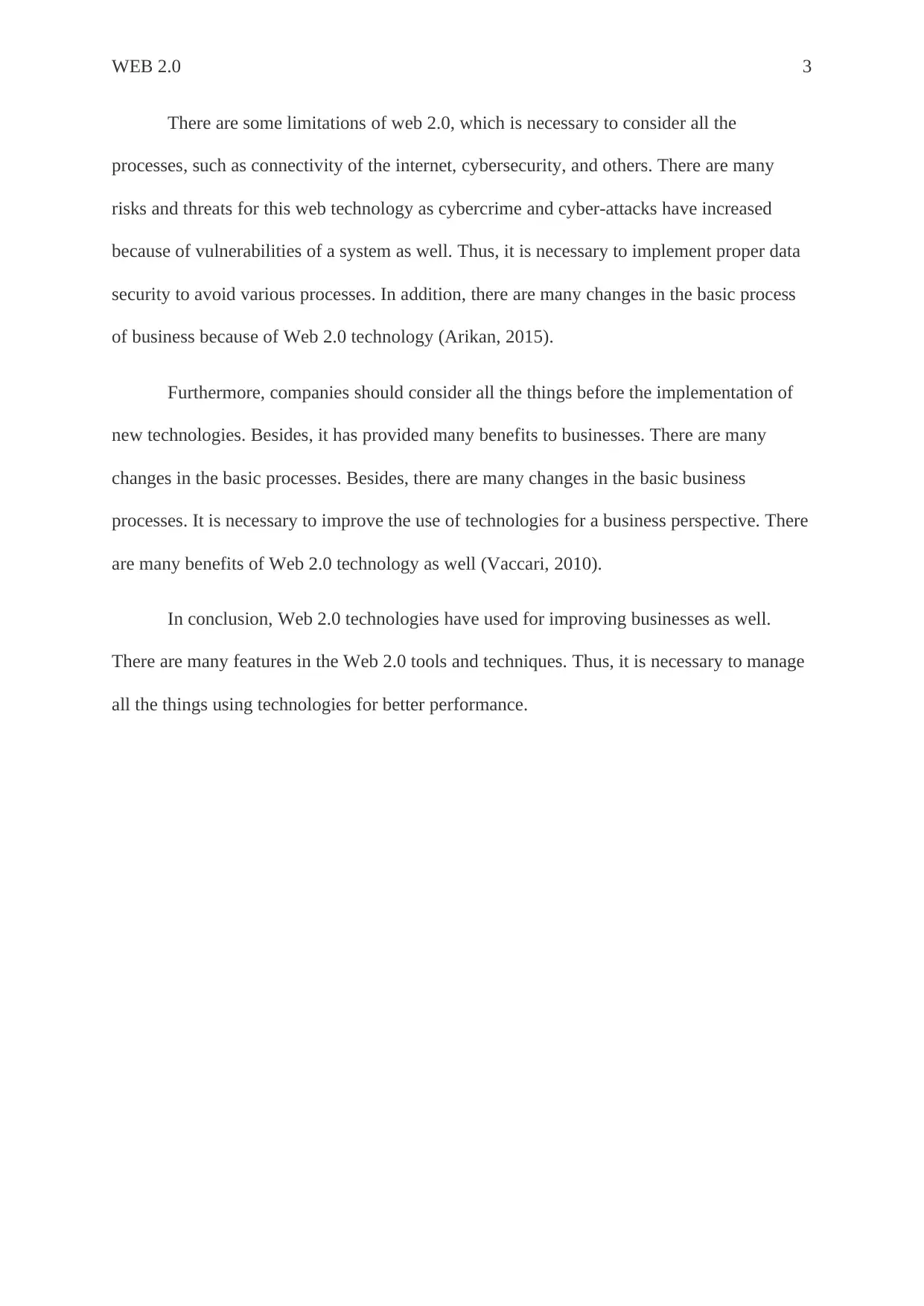
WEB 2.0 3
There are some limitations of web 2.0, which is necessary to consider all the
processes, such as connectivity of the internet, cybersecurity, and others. There are many
risks and threats for this web technology as cybercrime and cyber-attacks have increased
because of vulnerabilities of a system as well. Thus, it is necessary to implement proper data
security to avoid various processes. In addition, there are many changes in the basic process
of business because of Web 2.0 technology (Arikan, 2015).
Furthermore, companies should consider all the things before the implementation of
new technologies. Besides, it has provided many benefits to businesses. There are many
changes in the basic processes. Besides, there are many changes in the basic business
processes. It is necessary to improve the use of technologies for a business perspective. There
are many benefits of Web 2.0 technology as well (Vaccari, 2010).
In conclusion, Web 2.0 technologies have used for improving businesses as well.
There are many features in the Web 2.0 tools and techniques. Thus, it is necessary to manage
all the things using technologies for better performance.
There are some limitations of web 2.0, which is necessary to consider all the
processes, such as connectivity of the internet, cybersecurity, and others. There are many
risks and threats for this web technology as cybercrime and cyber-attacks have increased
because of vulnerabilities of a system as well. Thus, it is necessary to implement proper data
security to avoid various processes. In addition, there are many changes in the basic process
of business because of Web 2.0 technology (Arikan, 2015).
Furthermore, companies should consider all the things before the implementation of
new technologies. Besides, it has provided many benefits to businesses. There are many
changes in the basic processes. Besides, there are many changes in the basic business
processes. It is necessary to improve the use of technologies for a business perspective. There
are many benefits of Web 2.0 technology as well (Vaccari, 2010).
In conclusion, Web 2.0 technologies have used for improving businesses as well.
There are many features in the Web 2.0 tools and techniques. Thus, it is necessary to manage
all the things using technologies for better performance.
Paraphrase This Document
Need a fresh take? Get an instant paraphrase of this document with our AI Paraphraser
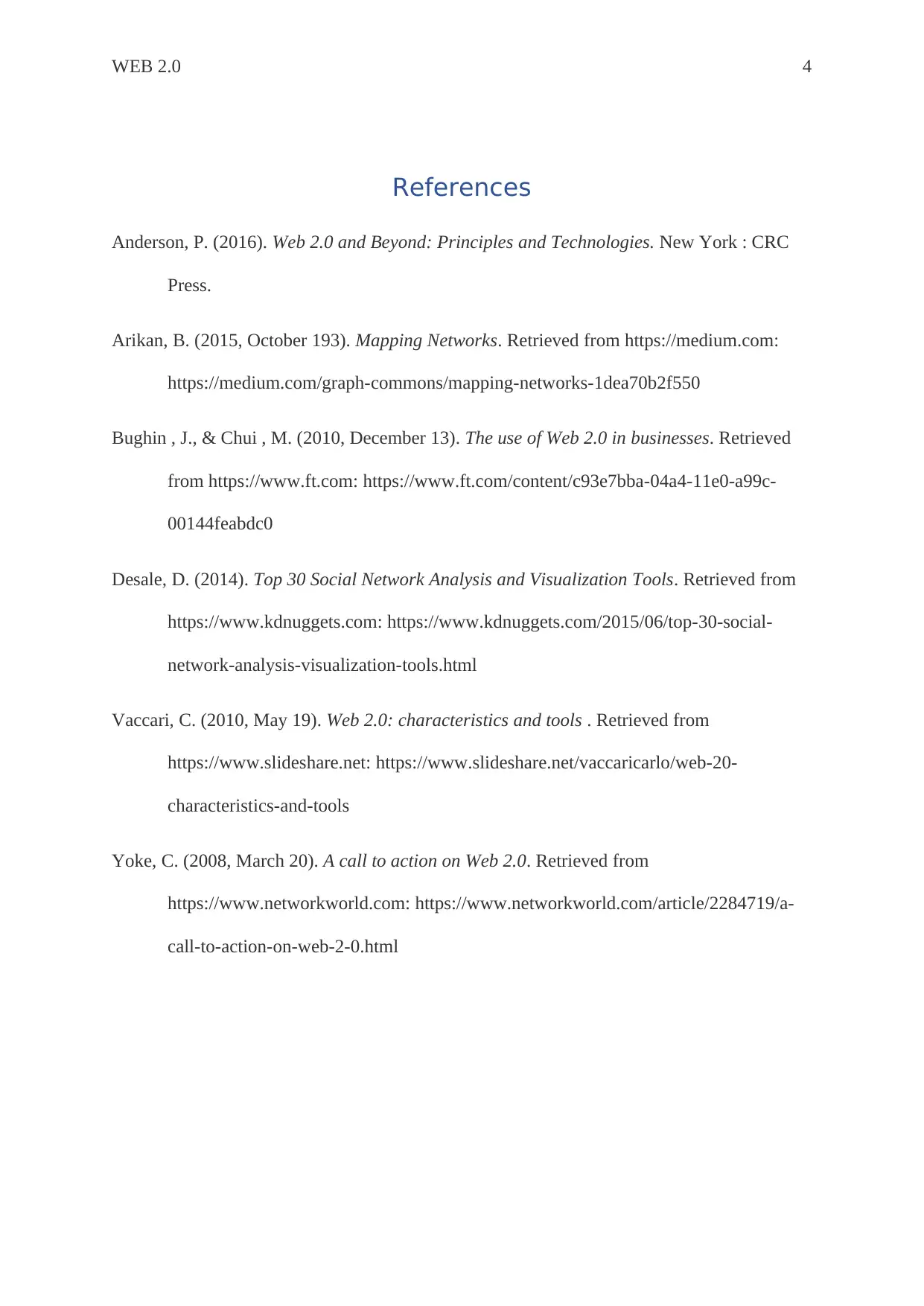
WEB 2.0 4
References
Anderson, P. (2016). Web 2.0 and Beyond: Principles and Technologies. New York : CRC
Press.
Arikan, B. (2015, October 193). Mapping Networks. Retrieved from https://medium.com:
https://medium.com/graph-commons/mapping-networks-1dea70b2f550
Bughin , J., & Chui , M. (2010, December 13). The use of Web 2.0 in businesses. Retrieved
from https://www.ft.com: https://www.ft.com/content/c93e7bba-04a4-11e0-a99c-
00144feabdc0
Desale, D. (2014). Top 30 Social Network Analysis and Visualization Tools. Retrieved from
https://www.kdnuggets.com: https://www.kdnuggets.com/2015/06/top-30-social-
network-analysis-visualization-tools.html
Vaccari, C. (2010, May 19). Web 2.0: characteristics and tools . Retrieved from
https://www.slideshare.net: https://www.slideshare.net/vaccaricarlo/web-20-
characteristics-and-tools
Yoke, C. (2008, March 20). A call to action on Web 2.0. Retrieved from
https://www.networkworld.com: https://www.networkworld.com/article/2284719/a-
call-to-action-on-web-2-0.html
References
Anderson, P. (2016). Web 2.0 and Beyond: Principles and Technologies. New York : CRC
Press.
Arikan, B. (2015, October 193). Mapping Networks. Retrieved from https://medium.com:
https://medium.com/graph-commons/mapping-networks-1dea70b2f550
Bughin , J., & Chui , M. (2010, December 13). The use of Web 2.0 in businesses. Retrieved
from https://www.ft.com: https://www.ft.com/content/c93e7bba-04a4-11e0-a99c-
00144feabdc0
Desale, D. (2014). Top 30 Social Network Analysis and Visualization Tools. Retrieved from
https://www.kdnuggets.com: https://www.kdnuggets.com/2015/06/top-30-social-
network-analysis-visualization-tools.html
Vaccari, C. (2010, May 19). Web 2.0: characteristics and tools . Retrieved from
https://www.slideshare.net: https://www.slideshare.net/vaccaricarlo/web-20-
characteristics-and-tools
Yoke, C. (2008, March 20). A call to action on Web 2.0. Retrieved from
https://www.networkworld.com: https://www.networkworld.com/article/2284719/a-
call-to-action-on-web-2-0.html
1 out of 5
Related Documents
Your All-in-One AI-Powered Toolkit for Academic Success.
+13062052269
info@desklib.com
Available 24*7 on WhatsApp / Email
![[object Object]](/_next/static/media/star-bottom.7253800d.svg)
Unlock your academic potential
Copyright © 2020–2025 A2Z Services. All Rights Reserved. Developed and managed by ZUCOL.





